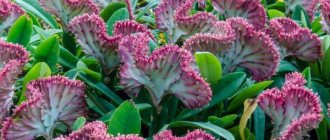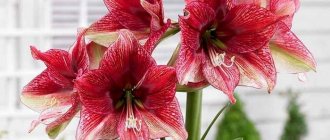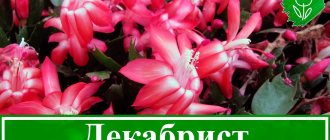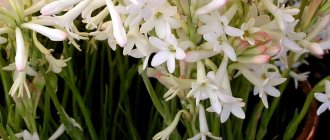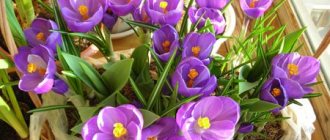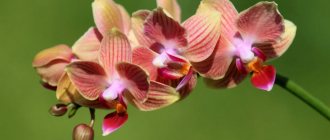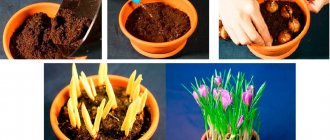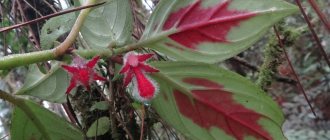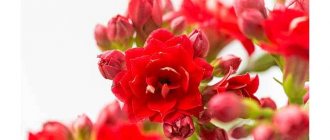Plants » Flowers
0
456
Article rating
Kira Stoletova
In modern gardening, spurge (euphorbia) is valued for its unpretentiousness and high decorative value. This crop is grown everywhere. Let's look at what varieties exist and how to care for them.
Euphorbia health benefits and harms
General characteristics of the plant
Euphorbia is a genus of herbaceous plants belonging to the Euphorbiaceae family. Latin name: Euphorbia.
Native to Madagascar and Mexican arid regions.
External features:
- has massive shoots;
- the leaves are oval, with pointed tips, of different colors - green, emerald, with a reddish, bluish or purple tint, depending on the subspecies;
- the root system can be superficial fibrous, tuberous or taprooted;
- blooms with small or medium inflorescences, there are plants with red, yellow, purple, pink or snow-white buds.
Almost all types of euphorbia, when broken, release milky juice, which is considered poisonous. When it comes into contact with the skin, it causes an allergic reaction - redness, irritation.
Purchase rules
You can purchase cultivated species of milkweed for growing in your garden or at home at any gardening store.
When buying a flower, you should carefully examine the crown - it is important that there are no signs of disease infection or mechanical injury. If the leaves do not fall off when you shake them off, it means the plant is fresh.
After purchase, indoor specimens need to be given time to adapt - they are placed in a three-week quarantine in a separate room.
Conditions of detention
For cultivation, you will need a loose, well-drained substrate with neutral acidity. You can also take a ready-made soil mixture intended for planting cacti and succulents. You can also prepare it yourself - mix turf, leaf soil, peat, brick chips and coarse sand in a ratio of 2:2:2:1:1.
This plant needs intense light throughout the year. It is placed on the south, southwest or southeast window sill. In sunny days, shade them to prevent the stems and leaves from burning.
In spring and summer, the optimal temperature in the apartment is 20-25°C. With the arrival of winter, the plant enters a dormant phase, so it requires coolness - kept at a temperature of 15-16°C.
It easily tolerates sudden increases or decreases, but does not like drafts. When the room is ventilated, it is taken to another room.
Possible problems in growing milkweed
Most plant species have excellent immunity and are rarely affected by pests and diseases. However, with poor quality care, it is possible that the condition of the flower will deteriorate.
Are there diseases and pests?
Excessive watering and drafts may cause yellowing and falling leaves. As the flower rots, brown spots appear on the leaves. It is recommended to reduce watering and move the pot to a dry and warm place.
A sharp fall of leaves indicates a possible lack of phosphorus. In such a case, it is necessary to feed euphorbia.
For your information! Severe falling of the lower sheets indicates poor watering and lack of moisture.
The plant can be affected by scale insects, whiteflies, and mealybugs. For treatment, folk remedies or special preparations diluted according to the instructions are used.
Euphobia, or milkweed, is an interesting and unpretentious plant that even an inexperienced gardener can grow. The flower does not require serious care and is unpretentious to conditions. If you wish, you can even achieve flowering at home.
Overview of varieties
Wild growing
There are several species of milkweed that grow successfully in the wild, occupying large areas.
Euphorbia photo of a weed with spiny leaves
- Bolotny. A perennial plant 50 cm high with erect stems and oblong green leaves. Umbrella-shaped inflorescences. Distributed in desert and steppe areas.
- Weed (weed). An annual plant with a succulent stem, compact in size - about 20 cm high. The inflorescences bloom in summer and look like red bells.
- Steppe. Its homeland is the coast of the Volga and Don, and is also found on the Caucasian slopes. A perennial crop with a vertically growing stem. It can bloom in small white or yellow inflorescences throughout the summer.
- Acute (field or meadow). Prefers to grow along rivers, covering large areas of pastures, meadows, fields and forests. They can be fed to chickens, pigs, chicks, turkey poults, and goslings.
Garden
In cultivated form, gardeners use several species of spurge with different life cycles.
1. Annuals.
- Bordered (mountain snow). In nature, it is found on mountain tops and rocky slopes. A very beautiful plant during the flowering phase forms a lush white crown - light green leaves are covered with snow-white stripes. They are decorated with white bracts. Blooms in early summer and fades in late autumn.
- Variegated. Decorative deciduous species with rich green foliage and erect stems. The flowers consist of red, white or variegated petals. The height of the shoots is about 1 m.
2. Perennial plants are decorative for several years in a row and have good winter hardiness. They are often grown for cutting because they last a long time in a bouquet.
- Cypress. The height of the bush is 0.5 m. The leaves are thin, needle-shaped, green. The flowers are small, beige, red or yellow.
- Fiery (Griffith). It grows quickly, so it takes up a lot of space in the garden. The leaves are green, with the arrival of autumn they acquire a reddish-red color. The flowers are small, reddish or orange in color.
- Fischer (Pallas, man-root or man-grass). A compact plant 20-60 cm high with erect, pubescent stems, densely covered with long and narrow leaves of a light green hue with a grayish tint. Prized for its colorful blooms, which begin in May and end in July. The flowers are small, lemon-colored, collected in umbrella inflorescences.
- Rod-like (vine). Single-stem plant, shoot height - 50-60 cm. Covered along the entire length with narrow leaves of a silver-green tone. At the top, inflorescences of small yellowish buds with a diameter of 1 cm are formed.
- Poisson. A beautiful, lush shrub that has decorative green foliage with elements of beige or white. The plant does not bloom, but due to the variegation of its leaves, it is very popular in landscape design. It is planted in flowerbeds, mixborders, and rock gardens.
Indoor
Perennial indoor species are valued not only for their decorative flowering, but also for their beautiful foliage, which delights with plain or variegated colors all year round.
Euphorbia ordinary photo
- Head of a jellyfish. An unusually shaped succulent with a short and thickened stem, with age it acquires numerous side shoots that develop in different directions. It is grown in hanging flowerpots and flowerpots - the green tentacle branches hang beautifully, creating the effect of a curly head.
- Variegated. One of the most common African succulents, which is also found in the wild in America, as well as on the island of Madagascar. In nature it reaches gigantic sizes - up to 10 m, in cultivated form - up to 2 m. The stems are fleshy, consisting of 5 ribs. The shoots are 5-7 cm thick. Short spines (3-4 mm long) develop on the edges.
- Bristling. A plant with a well-branched crown. The stems develop in an upright position, abundantly covered with rudimentary leaves of rich green color.
- Triangular (triangular). This species with a bizarre shape has massive, well-branched, triangular stems. The edges of the ribs are prickly - spines of a grayish or yellow-brown tone.
- Large-horned. Develops triangular stems with small foliage at the top, which crumbles with age. Shoot height is 40-50 cm. Native to Mexico and Australia.
- Tirukalli (finger). A succulent consisting of numerous finger shoots. There are no thorns or leaves on their surface. With good care at home, it can bloom magnificently with small yellowish flowers.
- Canary. Scientific name: euphorbia canariensis. This is a large spurge in the form of a bush or tree, in natural conditions it reaches a height of 12 m. In cultivated form - 1-2 m. The stems are massive, four or five-sided. The ribs contain small tubercles. The diameter of the shoots is 5-6 cm. Rudimentary type leaves develop under each convexity. The stems are covered with thorns about 0.5 cm long.
- White-veined. The plant is recognized by its unusual leaves - they are green and contain clearly defined transverse veins of white color.
- Mile (brilliant). The ornamental plant is popularly called crown of thorns. Forms a dense crown with lush branching. Beautiful red or scarlet flowers bloom at the top of the stems. The shoots are covered with thorns.
- Poinsettia. Other names: most beautiful spurge, Christmas star. It is bought on the eve of Catholic Christmas. A flower with bright red stipules forming large inflorescences at the top of the shoots decorates any interior. This plant is an annual and can bloom in December.
- Fat. The plant is in the shape of a cactus, 30 cm high and 10 cm in circumference. The stem is ribbed, divided into several weakly defined edges. Buds form on each, and eventually leaves.
- Lactea. A beautiful plant with emerald foliage and colorful blooms that, with good care, last throughout the year.
How to make milkweed bloom
- Diamond frost. The crown resembles a hat consisting of thin emerald stems covered with small white flowers.
- Ordinary (ordinary). This species has a compact crown - the stems are erect, with medium foliage. The leaves are green, oval with pointed tips. It blooms with small yellow or white buds collected in umbrella inflorescences.
- Myrsinites climber. A plant with erect stems covered with long dark green leaves. The flowering is inconspicuous - the buds are small, pale yellow or white. Valued for its decorative leaves, which do not fall off all year round.
- Volodushkolistny (hare's ears, in Latin - bupleurifolia). This is a perennial succulent with lanceolate-spatulate leaves, 5-7x3 cm in size and a thick short stem 20 cm high, 7 cm in circumference. The surface of the shoot is covered with brown, hard scales. The leaves develop at the top, forming a loose rosette. In appearance it resembles prostrate spurge. In the winter season the foliage falls.
- Almond purpurea. Botanical name: euphorbia amygdaloides purpurea. One of the most decorative varieties with dark purple, erect stems, densely covered with narrow leaves (length 8-10 cm, width 1 cm). The color of the leaf plate is emerald with a burgundy tint. Height - from 40 to 60 cm. At the top of each stem, several small inflorescences are formed, consisting of light green or light green, rounded petals.
- Comb-costal. Medium height - up to 50 cm, forms tiny white flowers framed by red or pink bracts. The ridge-shaped stems are tetrahedral.
General description of the flower with photo
Euphorbia is represented by a group of annual and perennial succulents.
This is a plant with fleshy leaves in which moisture accumulates. When the leaf blade is damaged, toxic juice is released. It contains euphorbon, mineral salts, amorphous copper. The root system is in the form of a rhizome. The stems are erect or prostrate-branched, reaching a length of up to 2 m. Important! Most plants in the spurge family are poisonous.
The plant is characterized by an unusual type of inflorescence - cyathium, it consists of several stamens and one pistil. The flowers are surrounded by bracts that differ in color. The flowering time of most euphorbias is from June to the first month of autumn. Some plant varieties are dioecious - euphorbia bears only male or female flowers. The fruits are three-lobed and fall into 3 single-seeded nuts.
Landing
For planting, use a container that is not too deep, but wide, since almost all species have an extensive superficial root system.
Why did the spurge suddenly turn yellow?
A pot made of ceramic, clay or plastic with drainage holes in the bottom is suitable.
Technology:
- Expanded clay and fertile soil are filled in.
- The roots are lowered, covered with soil to the top, compacted, and watered with water at room temperature.
- Install a support so that the plant takes a vertical position.
Features of care
In order to achieve maximum decorative value from milkweed, it is necessary to ensure proper maintenance conditions.
Watering
Water abundantly, but only after the soil has dried to a depth of 4-5 cm. If it is a cactus-like plant, watering should be scanty, since the lack of moisture is replenished due to the fleshy and succulent stems.
In winter, water very rarely - no more than once a month to avoid waterlogging and rotting of the root system.
Feeding
To increase immunity and to make it bloom, you can feed euphorbia with a mineral composition for cacti and succulents.
Apply fertilizer once a week, following the dosage indicated on the package. After this, abundant watering is carried out so that the roots quickly absorb the nutrients. In winter, during the resting phase, they do not feed.
Trimming
Euphorbia white-tipped and ribbed; cactus varieties do not need pruning. You can pinch all the rest so that they bush well.
Pinching is done on the apical shoots - carefully separate the stems to 2-3 cm in length. This will stimulate the development of new shoots.
Additionally, throughout the growing season, diseased stems and leaves are trimmed. For shaping and sanitary cutting, use a sterile and well-sharpened instrument to avoid excessive injury and infection.
Transfer rules
Be sure to replant purchased flowers, because the store-bought substrate does not contain useful substances for growth and flowering.
- Take a container 2-3 cm larger in diameter than the old flowerpot.
- Drainage is placed on the bottom and half filled with nutrient composition. Water the flower, remove it and, together with the earthen lump, transfer it to a new pot.
- If necessary, fill the soil to the top and moisten it.
The frequency of transplanting domestic euphorbias depends on age: young - every year, adults - once every 5 years.
If the roots of a plant have rotted, it also needs to be replanted, otherwise it will die.
- The flower is removed from the flowerpot, washed from the soil, the rot is cut out to healthy tissue, and dipped in a fungicide solution for an hour.
- Then they are dried, the cut areas are sprinkled with charcoal, and they are planted in a new container with a sterile soil mixture.
Caring for euphorbia at home
It is very easy to grow such plants indoors, because most of them are absolutely undemanding in care. They are resistant to dry soil, not susceptible to attack by pests, and also feel great on south-facing windows.
Temperature
In summer, the air temperature should be from 20 to 25 degrees, and in winter - about 16 degrees. A species such as poinsettia requires a cold winter, while all others are quite capable of staying at normal room temperature in the winter.
Illumination
These are light-loving plants that are best placed on southern windows. If in winter there is little light for the milkweed and it is kept warm, then its shoots become very elongated and their decorative properties are lost. Absolutely all types can be moved outside in the warm season.
Humidity
Low air humidity is tolerated quite well by euphorbias. However, it is recommended to regularly spray them with lukewarm water for hygienic purposes (to remove dust).
How to water
Watering depends entirely on the type of plant. But almost all succulents are watered very rarely. So, in winter they need to be watered once every 4 weeks, but the earthen clod should not be allowed to dry out completely. During active growth and flowering periods, watering should be more abundant.
Top dressing
Fertilizing is carried out in the spring and summer. To do this, use special fertilizers for indoor plants or cacti.
Euphorbia transplant
Almost all types of euphorbia are slow-growing, so transplantation is carried out only if necessary. For small milkweeds, choose low and small pots, and for tall plants, triangular milkweed and tirucallia, you need heavy and fairly deep dishes. Good drainage is needed.
Euphorbia Enopla - Cute Poison Spike
Earth mixture
The soil should be loose and the root system should not be allowed to grow too much. A suitable soil mixture consists of leaf, turf and peat soil, as well as sand, taken in equal portions. It is also recommended to pour a little brick chips or perlite into it. A soil mixture for cacti is also suitable.
Reproduction of euphorbia
Propagated by cuttings. Before planting the cuttings, it should be dried for several hours. You don’t have to cover the cuttings, but they should be placed in a warm place. Rooting occurs easily and quickly.
Pests and diseases
Almost all species are not susceptible to diseases and pests.
Euphorbia euphorbia / houseplant Euphorbia (1 part)
Reproduction methods
Children
This method is suitable for cactus euphorbias. Separate the baby along with the resulting roots using a sharp knife. Treat with Kornevin solution so that it takes root faster.
How to replant euphorbia in the countryside
Planted in a nutrient substrate for succulents and cacti. From such a shoot you can grow a varietal plant.
Cuttings
Method for plants with good branching. At the top, select several shoots with leaves and buds and cut them off.
The optimal length of the cuttings is 15-20 cm. At the bottom, all leaves are torn off, dipped in water for a couple of hours to allow the milky juice to drain, then dried.
They are planted when a thin film appears on the cuts. It can be rooted in a light and loose substrate of peat and sand. The seedlings are watered with warm water, covered with a transparent cap, and placed in a warm and well-lit place. Ventilate daily and moisturize if necessary.
After about 2-3 weeks, each sprout will begin to develop leaves, then the shelter is removed. They grow for another month so that the seedlings grow roots, then they are planted individually.
This method of propagation makes it possible to obtain new specimens with all the varietal characteristics of the mother plant.
Euphorbia reproduces by seeds in the wild; in private floriculture, this method is rarely practiced, because the seeds have poor germination. At home, it is difficult to create the necessary conditions for seed germination.
Features of breeding in open ground
- Growing euphorbia in open ground will not cause much trouble.
But only garden species of milkweed are suitable for this, and these are mostly perennials. The plant feels good in sunny places and in partial shade, although in the latter case it does not bloom so profusely, so such areas are more suitable for decorative deciduous varieties that can be grown as a “carpet”. - Even indoor spurge propagates well by seeds sown, as a rule, in the spring, and when carried by the wind they easily sprout anywhere in the area.
Having discovered such seedlings, you can dig up the plant and transplant it where you need it, although, despite its unpretentiousness, the plant does not like replanting and takes a long time to adapt, lagging behind bushes sown with seeds in growth. - In warm regions of the country, annual milkweed seeds are sown in early spring, in colder regions - through seedlings or sowing seeds before winter (late autumn), they will undergo natural stratification and grow stronger.
A month after the sprouts appear, the plant can be replanted, or, if sowing was already done in a permanent place, the plantings are thinned out. Planting of finished seedlings in the ground occurs when the threat of frost has passed. When planting using the division method, time does not matter. Some varieties require the installation of a support to which the seedling is tied after planting. The pruning rules are simple, shoots are removed as needed, this will stimulate re-blooming at the end of the season. - The bushes are fed once or twice a season with mineral fertilizers for garden plants, but you can also take those intended for indoor plants. Most varieties of euphorbia tolerate winter well without shelter, but in cold regions it is better to cover the bushes with spruce branches, sawdust, and covering material.
Diseases and pests
Euphorbia contains a milky sap that releases toxins and is therefore rarely damaged by insects or infections. Infection and loss of decorative properties are possible if the plant is not taken care of.
| Diseases and pests | Diagnostics | Treatment | Prevention |
| Root rot | Appears in plants that are often overwatered with cold water. A fungal infection affects the roots, then spreads to the stems - they darken, become covered with plaque, soften and die | The flower is removed from the flowerpot; if the root is completely rotten, it is disposed of. Before this, a couple of stems are cut for rooting. A plant that is partially damaged is washed from the soil, all rot is cut out, and dipped in a fungicide solution for an hour. Dry, plant in a new pot with a sterile substrate | Adjust watering. Use room temperature water for hydration |
| Powdery mildew | Shoots and leaves are covered with a whitish powdery coating. Over time, the affected areas turn black, rot and die | The control measures are as follows: cut out all the places that have drooped and have acquired an unnatural color. You can get rid of the sore if you treat the crown with fungicides - Ridomil Gold, Skor, Topaz or Hom | Provide the required level of humidity, avoid overwatering, regularly remove yellowed, shriveled and rotten organs |
| Bacteriosis | Inhibits plant growth and flowering. Leaves and stems become covered with weeping spots that emit an unpleasant odor | It is impossible to save such a flower, because it cannot be treated | Follow the rules of care and maintenance, avoid mechanical damage |
| Mosaic | The leaves are covered with a mottled pattern of red, yellow or white spots. Chlorosis appears later. Foliage turns yellow and becomes deformed | Treatment with insecticides - Fitoverm, Topaz, Aktara | Buying healthy plants; spraying pesticides in spring and autumn |
| Alternaria blight | A fungal infection that appears as dense brown growths on the surface of leaves and stems | The diseased areas are cut out and treated with Skor, Bordeaux mixture or Ridomil gold. | Buy healthy flowers, use sterile soil for planting and replanting |
| Mealybug | It leaves a whitish coating on the surface of the leaf plate, which darkens over time. The affected areas dry out and die. This type of spurge sheds its leaves en masse | Collect all the leaves that have fallen, cut off the diseased ones. You can destroy insects with Dichlorvos, Karbofos | Application of fresh and disinfected soil for cultivation |
| Shchitovka | Brown or red growths in the form of plaques stick to the surface of the stems and leaves. They suck the juices out of them. In places of parasitism, tissues turn black and die | Cutting out all damaged parts, treating with Actellik or Fosbicide twice with an interval of 7 days | To avoid having to fight this parasite, you need to follow all the rules of care and trim non-viable organs in a timely manner. Buy healthy plants and quarantine them |
| Aphid | Light green bugs settle in colonies on the underside of leaves. They feed on their juice, which leads to curling, drying out and falling off. | Euphorbia that has turned yellow and dried out must be freed from damaged parts. Then treat with Fitoverm or Actellik | Timely removal of rotten and yellowed shoots of leaves. Buying healthy flowers |
Signs and superstitions
There are several popular beliefs about this flower:
- Indoor spurge brings harmony into the house and improves mood.
- The great benefit of a flowering plant is its ability to attract happiness and tranquility.
- It should be kept in the apartment for emotional people. It pacifies, relieves tension and helps to cope with stressful situations more easily.
- White-faced infects with good energy - protects against damage, the evil eye, and the evil thoughts of ill-wishers.
- According to Feng Shui, the species with thorns should not be kept in the bedroom or children's room. It has negative magical properties and attracts discord, illness and misfortune for all family members.
Description of euphorbia
The height of milkweed is from 2 cm to 2 meters. The stems are straight, thin or fleshy, in the form of columns and triangles, with wide or thin leaves, often with spines.
Natural environment tropics of Asia, Africa, Madagascar. The juice of all types is hot, has a pungent aroma, is poisonous, contains sugar, rubber, essential oil, resin, euphorin, which burns mucous membranes and skin.
Most species of milkweed have inconspicuous flowers (there is no perianth, stamens and single pistils). The fruits of the capsule “shoot” euphorbia seeds, which quickly germinate.
Succulents are used in their homeland when planting hedges around residential buildings. Many varieties of milkweed are weeds, in Russia it is Euphorbia sungazer.
Can it be eaten?
Milky sap contains toxins that can cause severe poisoning not only in children, pets, but also in adults. Therefore, to avoid poisoning, eating stems and leaves is contraindicated. It is also possible for allergies to appear on the face and skin of the hands when exposed to milk. During care, you should wear rubber gloves and a mask to protect your eyes.
Euphorbia annual pinching and growing from seeds
Among all the varieties, only one species has unique healing properties - Pallas's euphorbia. It is widely used in folk medicine. The plant contains a large amount of useful minerals, acids, and vitamins. This is a powerful immunostimulant, the healing qualities of which are manifested in the ability to eliminate many ailments:
- ovarian diseases in women;
- prostate gland in men;
- infertility, mastopathy, fibroids;
- sexually transmitted infections;
- an excellent antifungal agent that treats warts, ulcers, scabies, boils, burns and abscesses;
- effective in preventing cancer.
The leaves and stems are used to prepare alcoholic tinctures and decoctions. Fresh milky sap is poisonous, so before drinking medicine based on this plant, you should consult a doctor so as not to harm the body.
Wild, weedy spurges are used as feed for rabbits, piglets, turkeys, chickens, and cows. They are rich in vitamins and beneficial microelements, increase immunity and productivity of animals and birds.
